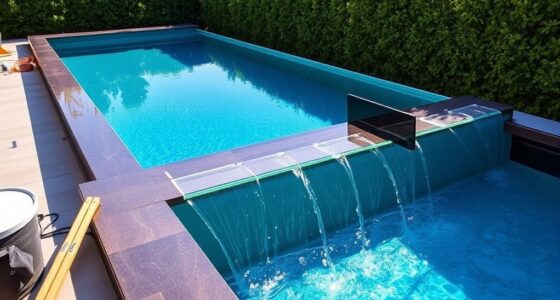Infinity pool catch basins capture excess water, debris, and surface runoff to keep your pool functioning smoothly and looking pristine. They work by guiding water through grates or screens into a collection chamber, where debris is filtered out before the water is pumped back into the main pool. Proper design and maintenance prevent overflow, control flow, and guarantee clean, safe water. To discover how these systems integrate seamlessly into your pool, continue exploring this essential feature.
Key Takeaways
- Catch basins collect excess water, debris, and leaves washing over the infinity pool edge to prevent clogs and damage.
- They regulate water flow, maintaining consistent water levels for aesthetic appeal and smooth pool operation.
- Components like grates, filters, and overflow edges work together to filter debris and manage surface runoff effectively.
- Proper maintenance and debris removal ensure the catch basin functions efficiently, preventing backups and prolonging system lifespan.
- They enhance environmental protection by controlling pollutants and contribute to the pool’s aesthetic appeal and long-term sustainability.
Understanding the Role of Catch Basins in Infinity Pools

While infinity pools create the seamless illusion of water extending to the horizon, catch basins play an essential role in maintaining their functionality. You might not see them, but they’re indispensable for keeping the pool’s water clean and balanced. Catch basins collect excess water, debris, and leaves that might wash over the edge, preventing clogs in the filtration system. They also help control water flow, ensuring the water level remains consistent. Without catch basins, debris could clog pumps or cause water to spill over the sides, damaging the pool structure. By efficiently capturing runoff and debris, catch basins enable your infinity pool to look pristine and operate smoothly. Their role is indispensable for both aesthetic appeal and long-term maintenance, especially since regular filter maintenance is crucial for optimal performance.
Components of an Infinity Pool Catch Basin
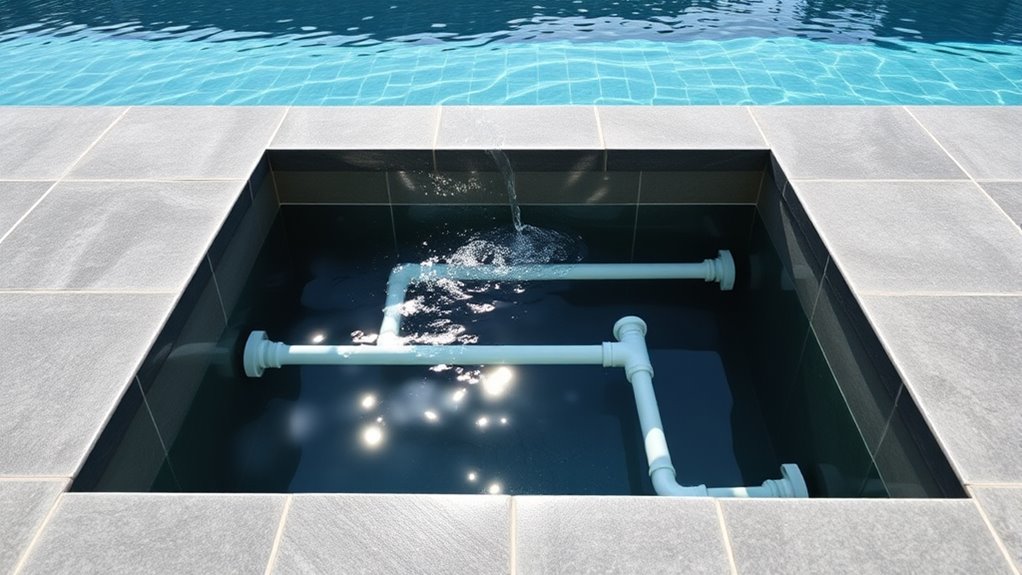
An infinity pool catch basin comprises several key components that work together to guarantee proper water management. The basin itself is a large, durable container designed to hold excess water. Inside, you’ll find a grate or screen that filters debris before water enters the basin, preventing clogs. A skimming lip or overflow edge allows water to spill over safely into the basin, maintaining the pool’s aesthetic. A sump or collection chamber captures water, directing it toward the pump system. The pump then circulates water back into the pool, ensuring continuous flow. Finally, a drain or outlet at the bottom of the basin facilitates water removal for cleaning or maintenance. Each component plays an essential role in keeping your infinity pool functioning smoothly and looking pristine. Proper water management is crucial for maintaining the longevity and visual appeal of your infinity pool system.
How Water Flows Into the Catch Basin
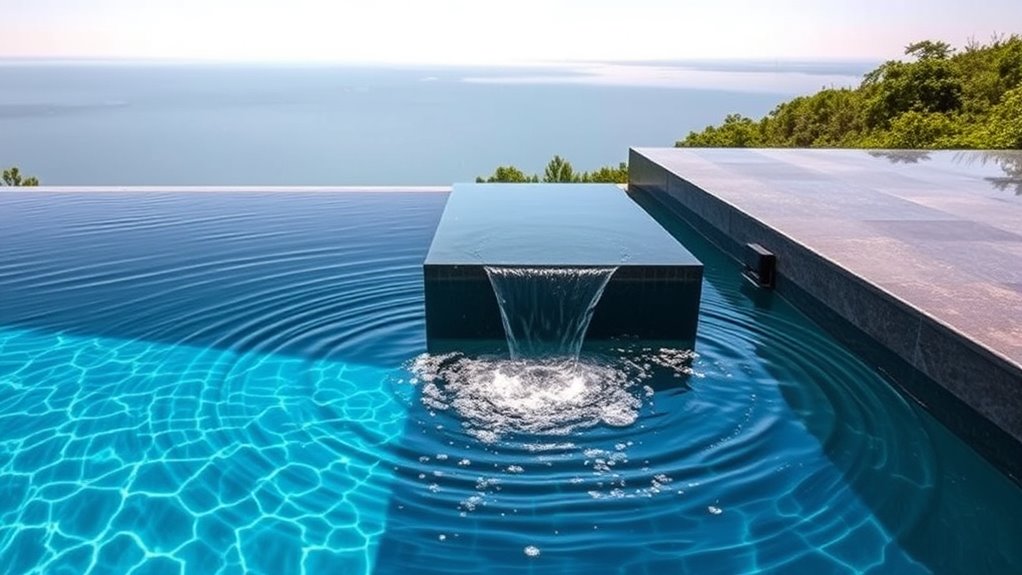
You’ll notice water enters the catch basin primarily through surface runoff entry points. The grate and filter work together to catch debris and direct water smoothly into the system. From there, water flows in a specific direction toward the basin’s interior for proper drainage. Additionally, understanding sound vibrations and their influence on cellular health can highlight the importance of maintaining clear water flow to prevent blockages that could disrupt the system’s efficiency.
Surface Runoff Entry Points
Surface runoff typically enters an infinity pool catch basin through designated entry points designed to efficiently direct water into the system. These entry points are strategically placed to maximize flow capture and minimize debris entry. You’ll find openings at specific locations around the basin, often positioned where runoff is most concentrated, such as near slopes or paved surfaces. These openings are engineered to handle varying flow volumes, ensuring quick water entry while reducing splash and turbulence. Sometimes, multiple entry points work together to distribute water evenly across the basin. Proper placement and design of these entry points are vital for preventing overflow and ensuring the basin functions effectively during heavy rain. They serve as the first step in managing surface runoff before filtration and drainage. Additionally, incorporating proper grading around the basin can further enhance water flow efficiency and prevent erosion.
Grate and Filter Role
When water reaches the catch basin, it first encounters a grate designed to allow smooth entry while blocking larger debris. This grate is vital for preventing leaves, trash, and other large objects from entering the system, which could cause clogs or damage. Beneath the grate, a filter or screen may be installed to catch smaller particles like dirt, sand, and organic matter. These filters help keep the water clean and reduce the need for maintenance. As water flows through the grate and filter, it’s directed downward into the basin, ensuring a steady, controlled flow. This setup not only protects the internal components of the catch basin but also maintains effective drainage, preventing flooding and water buildup around the infinity pool area. Additionally, understanding water flow regulation can further optimize the system’s efficiency and longevity.
Water Flow Direction
Water naturally flows toward the catch basin through guiding channels or slopes designed to direct runoff efficiently. To ensure proper flow, consider these key factors:
- Sloped surfaces: Surfaces around the basin are graded to direct water into the opening.
- Inlet design: Strategically placed openings guide water from various directions into the basin.
- Channel placement: Channels lead water from rooftops, pavement, or landscape toward the basin.
- Obstruction clearance: Regularly remove debris that could block flow paths and cause backups.
- Proper equipment: Using suitable paint sprayers and accessories ensures efficient application and prevents clogs that could disrupt water flow.
The Role of Skimmers and Overflow Weirs
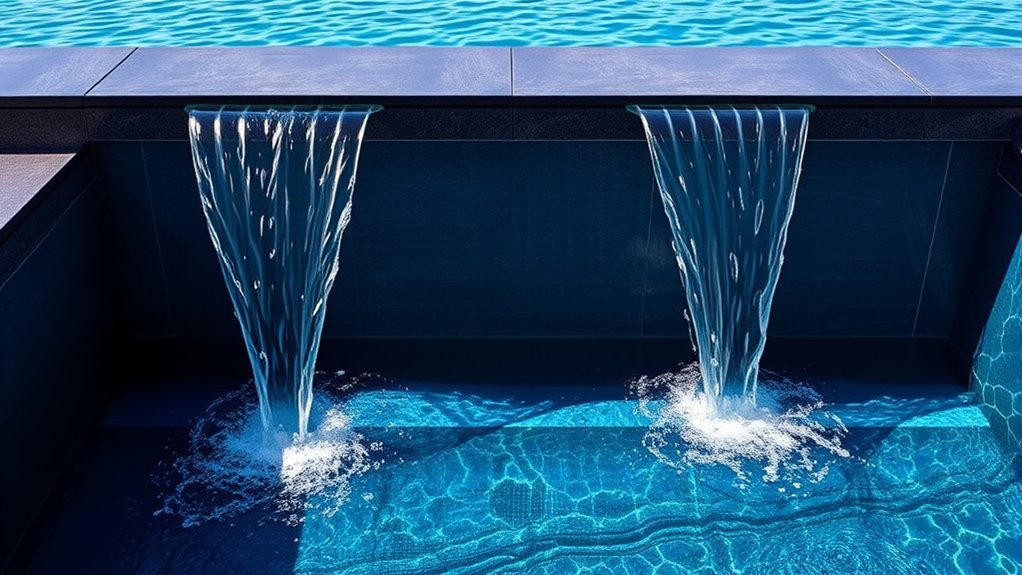
Skimmers and overflow weirs play a crucial role in maintaining clean and balanced infinity pools by effectively removing debris and excess water. Skimmers are strategically placed around the pool’s perimeter, catching leaves, dirt, and other floating particles before they sink. This prevents buildup that could clog the filtration system or affect water clarity. Overflow weirs, on the other hand, manage water levels by allowing surplus water to flow over the edge, preventing overflow and water damage. They ensure the water surface remains consistent, especially during heavy rain or high usage. Additionally, divorce statistics highlight the importance of professional guidance, much like how well-designed skimmers and overflow weirs work seamlessly to keep your pool water clean, safe, and visually appealing, acting as the first line of defense in your pool’s water circulation system.
Filtration and Debris Removal Processes
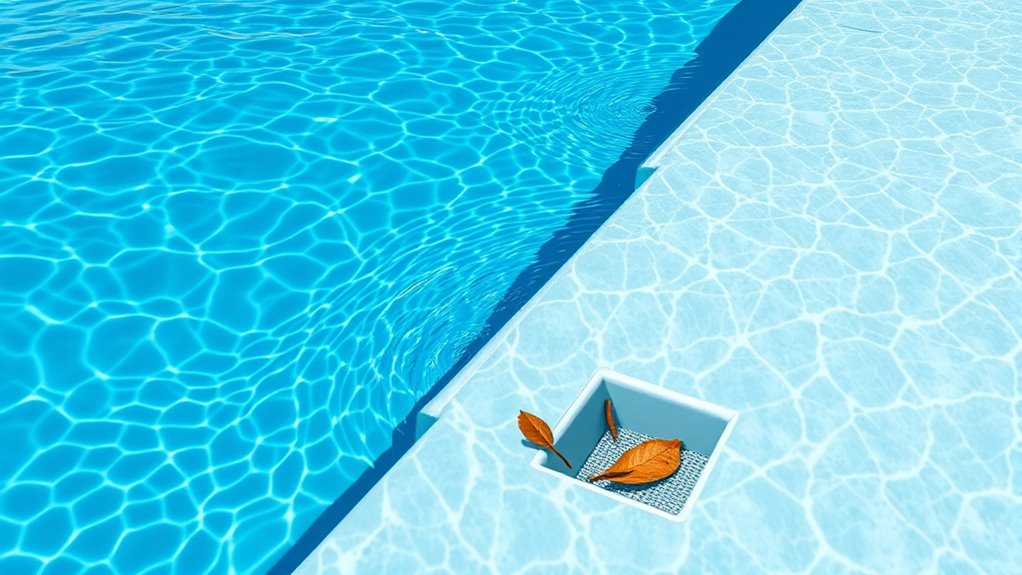
After debris is captured by skimmers and overflow weirs, the pool’s filtration system takes over to keep the water clear and balanced. Your filtration process works efficiently through these steps:
- Water flows into the filter, trapping dirt, leaves, and oils.
- The filter media, whether sand, cartridge, or diatomaceous earth, removes particles.
- Pumping circulates the cleaned water back into the pool.
- Regular backwashing or cartridge cleaning maintains peak performance.
- Employing advanced fraud detection techniques in the system can help identify unauthorized access or tampering.
This process ensures your infinity pool remains sparkling and free of contaminants. Proper filtration not only improves water clarity but also extends equipment lifespan. By actively removing debris, you prevent buildup that could hinder circulation or promote algae growth. Your filtration system is key to maintaining a pristine, inviting pool environment.
Pumping Water From the Catch Basin Back Into the Pool
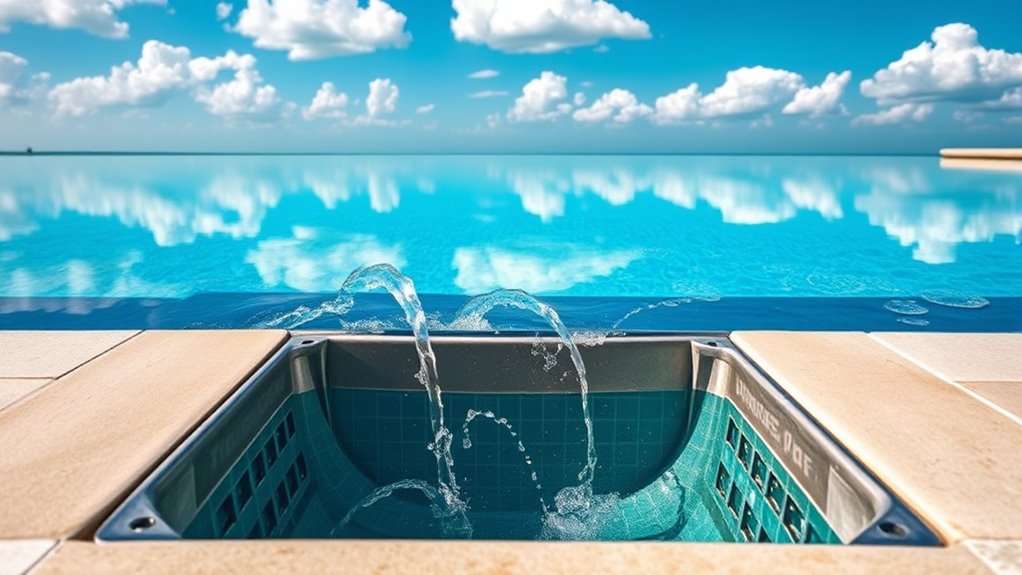
To keep your infinity pool circulating efficiently, you need to pump the water from the catch basin back into the main pool. This process guarantees continuous water movement, maintaining clarity and proper filtration. A pump draws water from the catch basin, which collects debris and excess water, and pushes it through the filtration system. Once filtered, the water is returned to the pool’s main body, helping to keep the water level steady and preventing stagnation. The pump’s capacity must match the pool’s size to maintain proper flow rates. Regular maintenance of the pump is essential to avoid clogs and mechanical failures. Ensuring proper water circulation is vital for maintaining the pool’s water quality and visual appeal. Properly managing this process ensures your infinity pool stays clean, balanced, and visually stunning with that signature edge illusion.
Preventing Overflow and Managing Excess Water
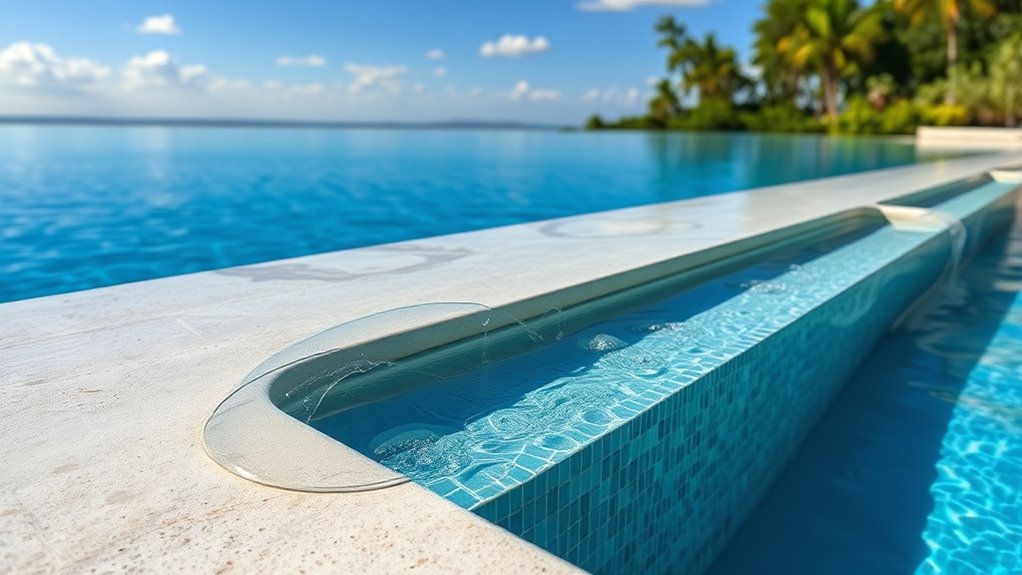
Since excess water can cause overflow and damage your infinity pool, it’s essential to implement effective management strategies. You can do this by:
- Installing a high-capacity catch basin to handle heavy rain or runoff.
- Using automatic sensors that trigger pumps when water reaches a certain level.
- Creating a secondary drainage system to divert excess water away from the pool area.
- Regularly inspecting and adjusting overflow outlets to ensure proper flow.
- Incorporating vertical storage solutions for pool equipment and accessories to keep the area organized and reduce clutter around the drainage systems.
These steps help prevent water from spilling over the edges, protecting your pool’s structure and surrounding landscape. Managing excess water efficiently minimizes damage, reduces maintenance needs, and keeps your infinity pool functioning smoothly during heavy rains or unexpected inflows. Proper overflow control is key to long-term pool health.
Maintenance and Cleaning of Catch Basins
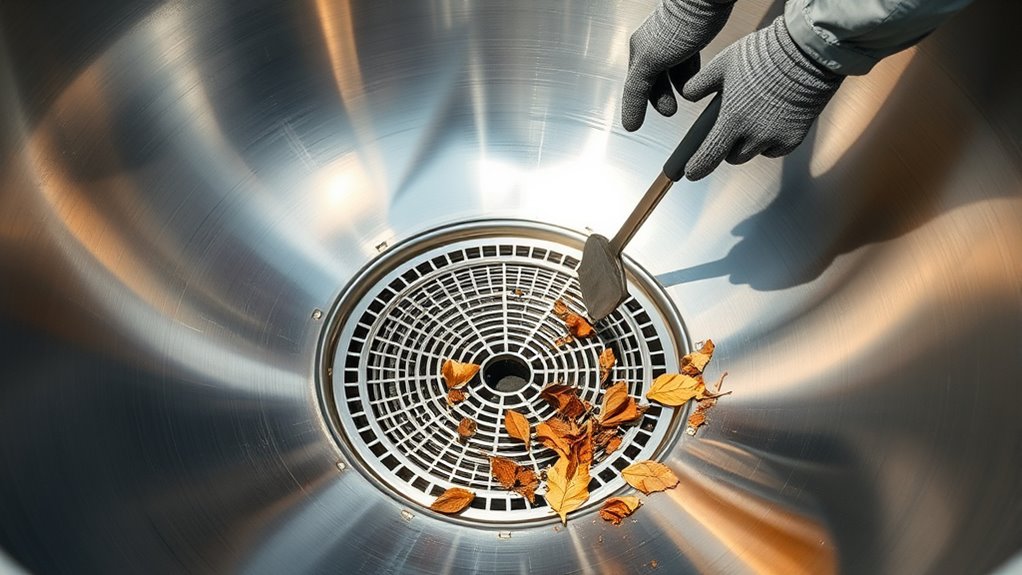
Regularly inspecting and cleaning your catch basins is essential to guarantee they function properly and prevent clogs. Start by removing debris such as leaves, dirt, and trash from the grate and basin interior. Use a shovel or scoop for larger debris and a hose to flush out smaller particles. Check for sediment buildup or obstructions that could impede water flow. Ensure the outlet pipe is clear and free-flowing. If you notice standing water after cleaning, it may indicate deeper blockages or issues needing professional attention. Regular maintenance helps avoid flooding, reduces erosion, and keeps water moving efficiently. Schedule inspections seasonally or after storms to maintain ideal performance and extend the lifespan of your catch basin system.
Engineering Design Considerations for Catch Basins
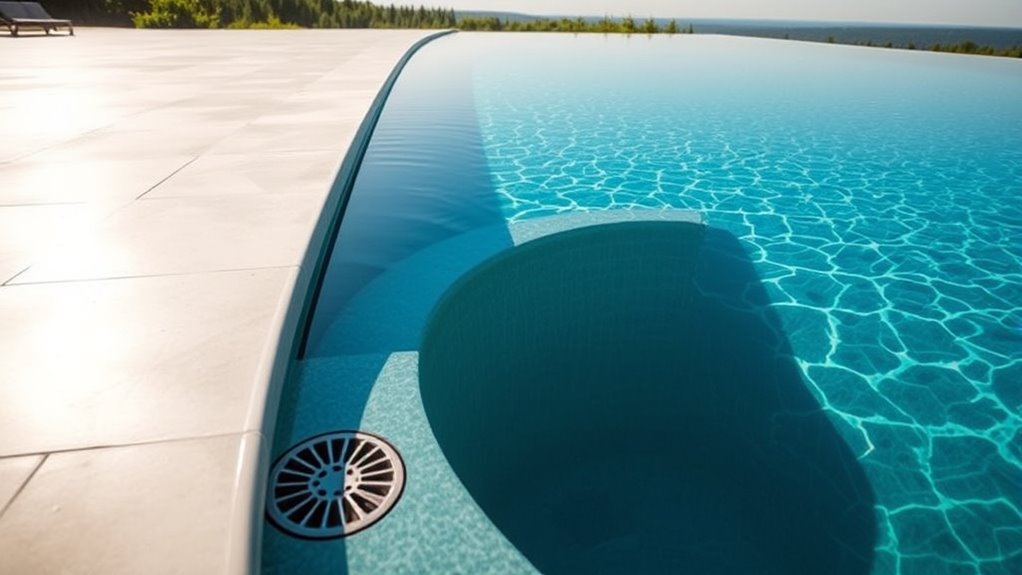
Effective engineering design of catch basins guarantees they efficiently manage stormwater runoff and prevent flooding. To achieve this, consider these key factors:
- Proper Sizing: Ensure the basin can handle peak runoff volumes based on local rainfall data.
- Inlet Placement: Position inlets strategically to capture runoff early and prevent erosion.
- Sediment Control: Incorporate filters or screens to trap debris and reduce clogging.
- Flow Capacity: Design internal components to promote smooth water flow and prevent backups.
The Environmental and Aesthetic Benefits of Proper Catch Basin Integration
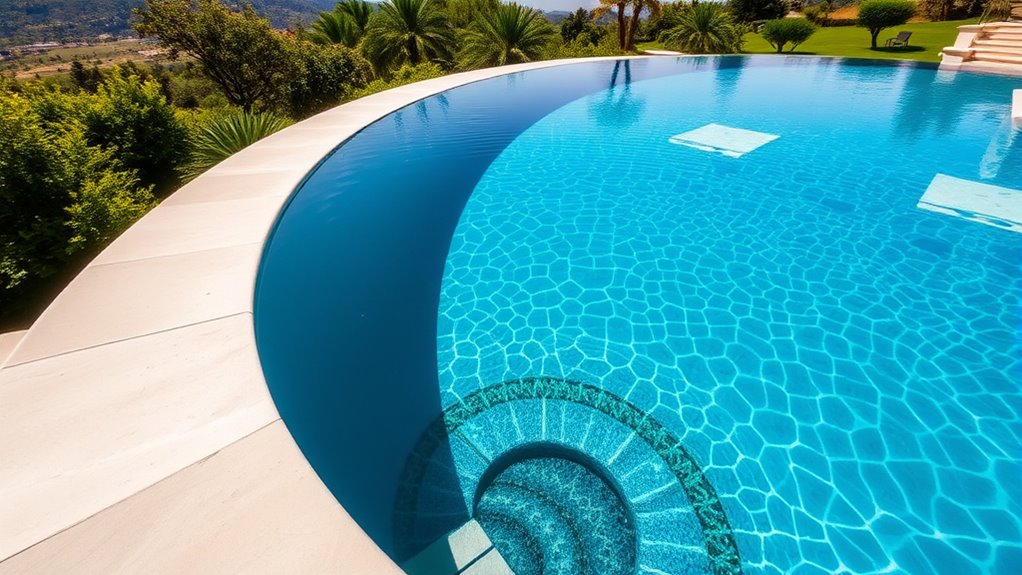
Properly integrated catch basins do more than manage stormwater—they enhance both the environment and the visual appeal of a community. When installed correctly, they prevent pollutants from reaching local waterways, protecting aquatic life and maintaining water quality. Aesthetically, well-designed catch basins blend seamlessly into landscapes, avoiding eyesores and complementing architectural features. This integration encourages community pride and promotes greener, cleaner surroundings. Additionally, effective catch basin placement reduces erosion and flooding risks, preserving the integrity of roads and infrastructure. By prioritizing environmental and aesthetic considerations, you create a safer, more attractive environment that benefits residents, wildlife, and future development. Proper integration demonstrates a commitment to sustainability, making your community not only functional but also visually appealing and ecologically responsible.
Frequently Asked Questions
How Does the Catch Basin Prevent Water Pollution in Infinity Pools?
You’ll find that the catch basin prevents water pollution in infinity pools by capturing debris, dirt, and contaminants before they enter the main water circulation. It filters out pollutants, ensuring cleaner water and reducing strain on the filtration system. This helps maintain water quality, prevents blockages, and minimizes environmental impact, making your pool safer and more environmentally friendly. Catch basins are essential for keeping your infinity pool beautiful and sustainable.
Can Catch Basins Handle Heavy Rainfall or Stormwater Runoff?
Imagine heavy rain pounding your infinity pool’s edge, yet the catch basin stands firm, silently channeling stormwater away. Yes, catch basins are designed to handle heavy rainfall and runoff by quickly collecting and directing excess water, preventing overflow and flooding. They act like vigilant guardians, ensuring your pool stays safe and clean even during intense storms, giving you peace of mind knowing your oasis remains pristine no matter the weather.
What Materials Are Best for Durable Catch Basin Construction?
You should choose materials like reinforced concrete, high-density polyethylene (HDPE), or fiberglass for durable catch basin construction. Reinforced concrete offers strength and longevity, handling heavy loads and harsh weather. HDPE provides excellent chemical resistance and flexibility, making it ideal for various environments. Fiberglass is lightweight yet sturdy, resisting corrosion. Using these materials guarantees your catch basin withstands heavy rainfall, stormwater runoff, and aging, maintaining its effectiveness over time.
How Do Catch Basins Impact the Overall Energy Efficiency of the Pool System?
You might think catch basins just sit there, but they actually boost your pool’s energy efficiency. They help regulate water flow, reduce pump strain, and prevent debris buildup, which means your system doesn’t have to work overtime. By maintaining a smoother, cleaner flow, they save energy and extend equipment lifespan. So, ironically, these unsung heroes keep your infinity pool running efficiently, saving you money and hassle in the long run.
Are There Eco-Friendly Options for Catch Basin Design and Operation?
Yes, you can select eco-friendly catch basin designs that use recycled materials and promote natural filtration. Consider systems with vegetative covers or bio-filtration features, which reduce chemical use and improve water quality. Additionally, choosing low-impact materials and energy-efficient pumps minimizes your environmental footprint. Regular maintenance guarantees peak performance, helping you maintain an eco-conscious pool system that conserves resources and supports sustainability.
Conclusion
Understanding how infinity pool catch basins work helps you appreciate their vital role in keeping your pool pristine and functional. With proper design and maintenance, you prevent headaches and guarantee smooth operation. Think of it as a well-oiled machine—everything needs to work together seamlessly. By paying attention to these details, you’ll keep your infinity pool looking stunning and running efficiently, proving that a little extra effort now pays off in the long run.


